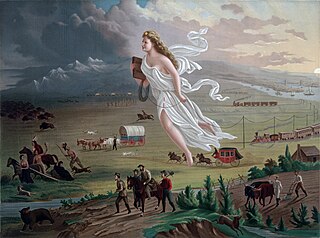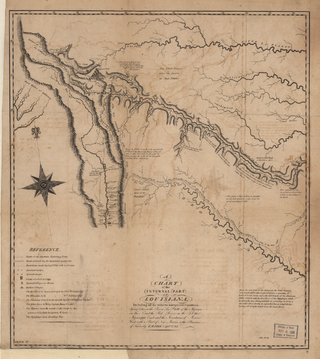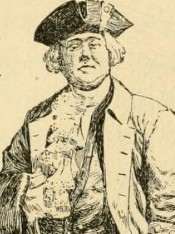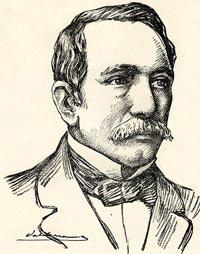Related Research Articles

The War of 1812 was fought by the United States and its allies against the United Kingdom and its allies in North America. It began when the United States declared war on Britain on 18 June 1812. Although peace terms were agreed upon in the December 1814 Treaty of Ghent, the war did not officially end until the peace treaty was ratified by the United States Congress on 17 February 1815.

Manifest destiny was a phrase in the 19th-century United States that represented the belief that American settlers were destined to expand westward across North America, and that this belief was both obvious ("manifest") and certain ("destiny"). The belief was rooted in American exceptionalism and Romantic nationalism, implying the inevitable spread of the Republican form of governance. It was one of the earliest expressions of American imperialism in the United States of America.

The Pike Expedition was a military party sent out by President Thomas Jefferson and authorized by the United States government to explore the south and west of the recent Louisiana Purchase. Roughly contemporaneous with the Lewis and Clark Expedition, it was led by United States Army Lieutenant Zebulon Pike, Jr. who was promoted to captain during the trip. It was the first official American effort to explore the western Great Plains and the Rocky Mountains in present-day Colorado. Pike contacted several Native American tribes during his travels and informed them that the U.S. now claimed their territory. The expedition documented the United States' discovery of Tava which was later renamed Pikes Peak in honor of Pike. After splitting up his men, Pike led the larger contingent to find the headwaters of the Red River. A smaller group returned safely to the U.S. Army fort in St. Louis, Missouri before winter set in.

William Walker was an American physician, lawyer, journalist, and mercenary. In the era of the expansion of the United States, driven by the doctrine of "manifest destiny", Walker organized unauthorized military expeditions into Mexico and Central America with the intention of establishing slaveholding colonies. Such an enterprise was known at the time as "filibustering".

The Ostend Manifesto, also known as the Ostend Circular, was a document written in 1854 that described the rationale for the United States to purchase Cuba from Spain while implying that the U.S. should declare war if Spain refused. Cuba's annexation had long been a goal of U.S. slaveholding expansionists. At the national level, American leaders had been satisfied to have the island remain in weak Spanish hands so long as it did not pass to a stronger power such as Britain or France. The Ostend Manifesto proposed a shift in foreign policy, justifying the use of force to seize Cuba in the name of national security. It resulted from debates over slavery in the United States, manifest destiny, and the Monroe Doctrine, as slaveholders sought new territory for the expansion of slavery.

George Mathews was an American soldier and politician from the U.S. States of Virginia and Georgia. He was a brevet brigadier general in the Continental Army, the 20th and 24th Governor of Georgia, a U.S. Representative from Georgia, and the leading participant in the Patriot War of East Florida.

Thomas ap Catesby Jones was an American naval officer who served during the War of 1812 and the Mexican–American War.
The first USS Sea Horse was a one-gun schooner that the Navy purchased in 1812 for service on Lake Borgne, near New Orleans, Louisiana. It is claimed she was one of 15 vessels available to Commodore Daniel Todd Patterson in New Orleans at the outbreak of war with Britain in 1812. The Sea Horse and USS Alligator accompanied a squadron of five gunboats at the end of 1814. In addition to these vessels, there was also a further gunboat at Fort St. Philip, as well as the USS Carolina (1812) and USS Louisiana (1812).

Narciso López de Urriola was a Venezuelan-born adventurer and Spanish Army general who is best known for his expeditions aimed at liberating Cuba from Spanish rule in the 1850s. His troops carried a flag that López had designed, which later became the flag of Cuba. Following his final failed attempt he was captured and garroted in Havana.

Amelia Island is a part of the Sea Islands chain that stretches along the East Coast of the United States from South Carolina to Florida; it is the southernmost of the Sea Islands, and the northernmost of the barrier islands on Florida's Atlantic coast. Lying in Nassau County, Florida, it is 13 miles (21 km) long and approximately 4 miles (6.4 km) wide at its widest point. The communities of Fernandina Beach, Amelia City, and American Beach are located on the island.

The Corps of Colonial Marines were two different British Marine units raised from former black slaves for service in the Americas, at the behest of Alexander Cochrane. The units were created at two separate periods: 1808-1810 during the Napoleonic Wars; and then again during the War of 1812; both units being disbanded once the military threat had passed. Apart from being created in each case by Cochrane, they had no connection with each other.
A filibuster, also known as a freebooter, is someone who engages in an unauthorized military expedition into a foreign country or territory to foster or support a political revolution or secession. The term is usually applied to United States citizens who incited insurrections across Latin America, particularly in the mid-19th century, usually with the goal of establishing an American-loyal regime that could later be annexed into the United States. Probably the most notable example is the Filibuster War initiated by William Walker in Nicaragua in the 1850s.

The Amelia Island affair was an episode in the history of Spanish Florida.
Jared Irwin was a United States Representative from Pennsylvania.

The Original Town of Fernandina Historic Site, also known as "Old Town", is a historic site in Fernandina Beach, Florida, located on Amelia Island. It is roughly bounded by Towngate Street, Bosque Bello Cemetery, Nassau, Marine, and Ladies Streets. On January 29, 1990, it was added to the U.S. National Register of Historic Places as a historic site. Lying north of the Fernandina Beach Historic District, it is accessible from North 14th Street.

The Battle of Lake Borgne was a coastal engagement between the Royal Navy and the U.S. Navy in the American South theatre of the War of 1812. It occurred on December 14, 1814 on Lake Borgne. The British victory allowed them to disembark their troops unhindered nine days later and to launch an offensive upon New Orleans on land.

The New Orleans Squadron or the New Orleans Station was a United States Navy squadron raised out of the growing threat the United Kingdom posed to Louisiana during the War of 1812. The first squadron consisted of over a dozen vessels and was mostly defeated during the war. Afterward, new ships were stationed at New Orleans which engaged in counter-piracy operations for over twenty years. The New Orleans Squadron was eventually merged with the Home Squadron.
The Patriot War was an attempt in 1812 to foment a rebellion in Spanish East Florida with the intent of annexing the province to the United States. The invasion and occupation of parts of East Florida had elements of filibustering, but was also supported by units of the United States Army, Navy and Marines, and by militia from Georgia and Tennessee. The rebellion was instigated by General George Mathews, who had been commissioned by United States President James Madison to accept any offer from local authorities to deliver any part of the Floridas to the United States, and to prevent the reoccupation of the Floridas by Great Britain. The rebellion was supported by the Patriot Army, which consisted primarily of citizens of Georgia. The Patriot Army, with the aid of U.S. Navy gunboats, was able to occupy Fernandina and parts of northeast Florida, but never gathered enough strength to attack St. Augustine. United States Army troops and Marines were later stationed in Florida in support of the Patriots. The occupation of parts of Florida lasted over a year, but after United States military units were withdrawn and Seminoles entered the conflict, the Patriots dissolved.

Fort San Carlos was a military structure built in 1816 to defend the Spanish colonial town of Fernandina, Florida, now called Old Town, which occupied a peninsula on the northern end of Amelia Island. The fort, a lunette fortification, stood on the southwest side of the town next to the harbor, on a bluff overlooking the Amelia River. It was made of wood and earthworks, backed with a wooden palisade on the east side, and armed with an eight or ten gun battery. Two blockhouses protected access by land on the south, while the village was surrounded with military pickets. An 1821 map of Fernandina shows that the street plan, laid out in 1811 in a grid pattern by the newly appointed Surveyor General of Spanish East Florida, George J. F. Clarke, today preserves nearly the same layout as that of 1821. The fort occupied the area bounded by the streets Calle de Estrada, Calle de White, and Calle de Someruelos. The structure itself has disappeared and only traces remain in what is now Fernandina Plaza Historic State Park.
The Port of Fernandina is located on Florida's Atlantic coast. It is used for terminal service for pulp and paper as well as steel exports, machinery, auto parts, chemicals, beverages, chemicals, building materials and food products. Container lines from the port serve routes to Colombia, Venezuela, the Dominican Republic, Haiti, Jamaica, Aruba, Curaçao and Bermuda.
References
- 1 2 "Gene Allen Smith". History Department. Texas Christian University. Retrieved April 1, 2018.
- ↑ McDonough, Daniel (August 1996). "Reviewed Work: "For the Purposes of Defense": The Politics of the Jeffersonian Gunboat Program by Gene A. Smith". The Journal of Southern History. 62 (3): 573–574. doi:10.2307/2211515. JSTOR 2211515.
- ↑ Ferrari, Mary (May 1999). "Reviewed Work: Filibusters and Expansionists: Jeffersonian Manifest Destiny, 1800-1821 by Frank Lawrence Owsley Jr., Gene A. Smith". The Journal of Southern History. 65 (2): 396–397. doi:10.2307/2587384. JSTOR 2587384.
- ↑ Cusick, James G. (Winter 2013). "Reviewed Work: The Slaves' Gamble: Choosing Sides in the War of 1812 by Gene Allen Smith". Journal of the Early Republic. 33 (4): 789–791. doi:10.1353/jer.2013.0086. JSTOR 24486802. S2CID 145772424.